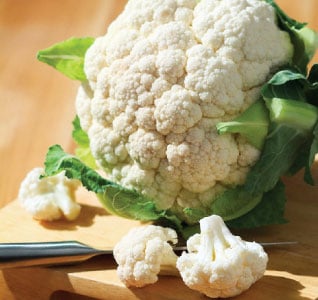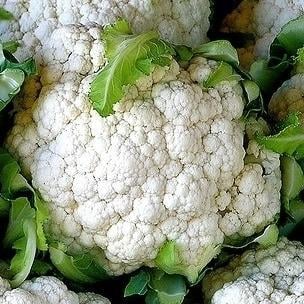
Learning Download: How to Grow Cauliflower
From Seed to Harvest: A beginner’s guide to growing cauliflower.
Cauliflower is a relative to broccoli and cabbage, and it is a cool-season vegetable, which makes it best for a fall harvest. It is a bit pickier than its green-budded relative, as it does not tolerate excessive heat or cold very well. Cauliflower requires consistent temperatures of around 60 degrees. Experienced gardeners may have more success with cauliflower than beginners.
To plant:
Prior to planting cauliflower seeds, add compost to the soil. This prevents “buttoning,” which is when a cauliflower produces smaller, button-shaped heads rather than a large, full head. Inconsistent temperatures can also cause buttoning.
Begin cauliflower plants indoors four weeks before the last frost but increase that time to seven weeks before the last frost if the spring season is short. Transplant the seedlings outdoors two weeks before the last frost. Space transplants about 18 inches apart in rows set 30 inches apart. For fall cauliflower, plant it six to eight weeks before the first frost but after 75-degree days.
To grow:
For spring cauliflower, cover the plants if it is projected to get too cold. For the fall crop, gardeners may need to shade their cauliflower if temperatures rise too high. Cauliflower takes nearly 80 days before it is ready to harvest. When the head is about 3 inches in diameter, tie outer leaves together with twine or a rubber band. This is called blanching, and it protects the head from the sun. The plant should be ready to harvest about a week or two after blanching.
To harvest:
Cauliflower heads should reach 6 to 8 inches in diameter before they are ready to harvest. The heads should be compact and firm. Heads may be smaller but already opening up and should therefore still be harvested. Course texture means the plant is over mature, and it should be pitched. To harvest, cut the cauliflower from the stem, leaving 2 inches of stem left on the head. To store it, place the head in a plastic bag and keep in the refrigerator.
What cauliflower craves:
Cauliflower requires full sun, and it does best in soil with a pH of 6.5 to 6.8. This vegetable requires 1 to 1.5 inches of water per week.
Where to buy cauliflower seeds:
You can find white, orange, purple and green varietals of cauliflower at Urban Farmer.
Learning Download: Common pests and diseases: Cauliflower
Common pests and diseases: Cauliflower
When growing vegetables, it is always exciting to care for the plant throughout its growing phase and then harvest it for delicious recipes later on, but one thing to watch out for is pests and diseases. Different plants are susceptible to different types of pests and diseases, and it is important to make yourself aware so you can keep a watchful eye and also take any preventative methods to keep your plants safe throughout their lifespan.
Cauliflower can fall victim to several different pests and diseases.
Pests:
There are several signs and symptoms a cauliflower plant will display if it is being affected by insects. The most common signs are holes in the leaves, missing foliage or poor vigor and missing vegetation. Several common pests affecting cauliflower plants are aphids, cabbage loopers, cabbage worms, slugs, snails and flea beetles.
Aphids are small insects with soft bodies. They can hurt cauliflower plants by sucking on its leaves or stems, or it can also produce a secretion that covers the plant’s flowers and stunts growth. A clue that you may have aphids is if you notice ants, because ants will farm the aphids for their secretion.
Cabbage loopers are light green with yellow stripes. This pest’s larva will create tunnels in the cauliflower’s white head.
There are several different kinds of cabbage worms, such as cabbage webworms and the imported cabbage worm. Cabbage webworms are small and green-striped. Imported cabbage worms are green with an orange stripe. The larva of insects, which typically are cabbage worms, are some of the most destructive pests to cauliflower.

Slugs and snails eat holes in the foliage and leave a slimy trail along the plant. You can pick them off at night, when they’re out and about, or use a diatomaceous earth treatment to control them.
Also use diatomaceous earth to control flea beetles, which will eat holes in the leaves and feed on the cauliflower’s young roots.
To treat other pests naturally, use horticultural soaps or pick the bugs off with your hands.
Diseases:
Diseases affecting cauliflower plants also can affect other cruciferous plants as well, so it’s good to know what they appear as so you can prevent them across your garden. The most common diseases for cauliflower are black spot, which is a fungal disease that turns the leaves yellow and causes them to drop from the plant; downy mildew, which is a fungus that attacks young and old plants, creates yellow spots and a white mold; bacterial soft rot, which can cause the plant’s roots to become soft and mushy and more. To help prevent cauliflower diseases, it’s important to practice crop rotation, add lime to the soil to prevent fungal infections and make sure there is plenty of space between plants for good air circulation.
Learning Download: Cauliflower Comparison Chart
Cauliflower Comparison Chart
| Variety | Days to Harvest | Color | Maturity | Cold Tolerance | Heat Tolerance |
| Amazing | 70-80 | White | Midseason | Good | Good |
| Cheddar | 60-70 | Dark orange | Early | Good | Very good |
| Graffiti | 70-80 | Purple | Midseason | Very good | Very good |
| Orange Dream | 60-70 | Pastel orange | Early | Good | Very good |
| Self Blanching** | 60-70 | White | Early | Very good | Good |
| Snow Crown | 50 | White | Early | Good | Good |
| Snowball Y Improved** | 70-80 | White | Midseason | Good | Good |
| Vitaverde | 70 | Green | Midseason | Very good | Very good |
*All American Selection Winner
**Heirloom
***AAS Winner/Heirloom

